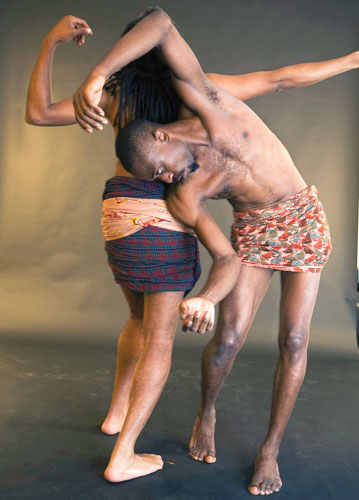In a project more than seven years in the making, choreographers Reggie Wilson and Andréya Ouamba are bringing their cross-cultural performance art to UCLA Live on Saturday.
Featuring the Brooklyn-based Fist & Heel Performance Group and the Senegal-based Compagnie 1er Temps Danse, “The Good Dance ”“ dakar/brooklyn” explores themes of the African diaspora through the medium of dance.
The collaboration of Ouamba, who is Congolese, and Wilson, who is black, allows a creative conversation between themselves and their respective dance groups and cultures.
“I met Andréya in 2002, in Senegal, when I was on a research trip for the Guggenheim Fellowship. I was exploring how contemporary African choreographers work. We got on really well,” Wilson said.
So when Wilson began to put together the initial basis of “The Good Dance ““ dakar/brooklyn,” Ouamba was the natural collaborator.
The piece, involving eight performers, including Ouamba and Wilson, brings together movement, singing and body percussion, and examines the links between the Mississippi Delta and the Congo.
However, the seeds of “The Good Dance ““ dakar/brooklyn” have been in the mind of Wilson since 1988, when he graduated from college. Since then, Wilson has been undertaking extensive research on African and African-American communities, allowing the performance to draw upon rich cultural backgrounds.
“I am very interested in anthropology and ethnography. It’s not science. It’s looking at how I relate to those communities, how I’m able to interact with them, what kind of impacts they have on my process,” Wilson said.
Much of this exploration of community stems from Wilson’s own familial background.
“I grew up In Milwaukee, Wisconsin, and my family is originally from the deep South, from Mississippi and Arkansas. So my research was actually going back to find out the more specific cultural information about what songs they grew up listening to, some of the practices they grew up with in the Baptist church,” he said.
Wilson then extended this research into Africa, initially exploring Zimbabwe before moving toward West Africa, in particular Senegal and Mali. However, Wilson became drawn to Central Africa and began to look at the links between the Congo and the experience of African-Americans within the USA.
“My research interest really started getting piqued as I entered Central Africa. I began looking at the real historical connections between African-American and Congolese or Central African culture,” he said.
In tying together these different cultural strands, Ouamba and Wilson create a postmodern, nonlinear portrait of the experience of the African diaspora in both Africa and the United States.
David Roussève, a professor of choreography, said he believes that cultural exchange within the arts is crucial as we move into the 21st century.
“Now that we’ve moved into a global world, people are trying to figure out how to collaborate across cultural boundaries,” Roussève said. “People are thinking how, for example, West African dance and modern dance can inform, change and strengthen each other. Dance is entering the global picture.”
In keeping with the postmodern and multicultural nature of the work, the choreographers leave the performance up to the audience’s own interpretation, presenting a piece that defies many of the conventions of traditional dance.
“The way that we both make our work, we’re not looking for specific narratives. People that have seen the piece think really different things,” Wilson said. “Some people like the music, the bodies moving within the space; some people like the images we try to create. If they have their own links to the Mississippi or the Congo it evokes memories for them,” Wilson said.
Wilson and Ouamba let the dance do the talking, allowing the dancers’ bodies to become a fluid text that the audience can interpret individually.
Andrew Hill, a graduate student and member of a West African dance and drumming group at UCLA, agrees that the body is an important vessel in conveying meaning within West African culture.
“Getting your body to move in a way that incorporates the messages of the music exposes these students to some of the multicultural flavor of West African rhythm,” Hill said. “Students get an idea about how rhythms were used historically, for celebrating the harvest, or for coming back after a long day fishing.”
